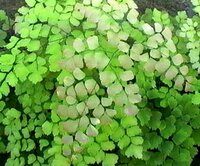hydrophyte
Member
- Joined
- 22 Aug 2009
- Messages
- 1,040
I am trying out a new plant that seems to have promise for riparium culture, Adiantum sp. "maidenhair ferns". I picked up this good-sized potted plant the other day at a local garden center.

There are quite a few maidenhair fern species and varieties in cultivation, but the label on this just indicated "maidenhair fern". We have a native Adiantum here in the Northern US (A. pedatum), but it doesn't really grow in wet situations. I have run into references for other different maidenhair ferns that describe wet habitats such as the margins of small, stony streams, so there should be some that are good candidates for growing in ripariums. If I get any good results from it I will try to figure out which species/variety it might be.
If it grows right this plant could be a good addition to a lower light setup with mosses and crypts and other ferns. My 55-gallon setup might be a good spot for it.

I will plan to pot it up in a riparium planter and see what happens.
There are quite a few maidenhair fern species and varieties in cultivation, but the label on this just indicated "maidenhair fern". We have a native Adiantum here in the Northern US (A. pedatum), but it doesn't really grow in wet situations. I have run into references for other different maidenhair ferns that describe wet habitats such as the margins of small, stony streams, so there should be some that are good candidates for growing in ripariums. If I get any good results from it I will try to figure out which species/variety it might be.
If it grows right this plant could be a good addition to a lower light setup with mosses and crypts and other ferns. My 55-gallon setup might be a good spot for it.
I will plan to pot it up in a riparium planter and see what happens.



